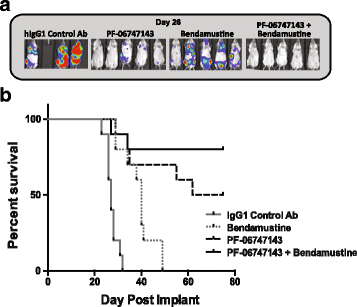Targeting the CXCR4 pathway using a novel anti-CXCR4 IgG1 antibody (PF-06747143) in chronic lymphocytic leukemia
- PMID: 28526063
- PMCID: PMC5438492
- DOI: 10.1186/s13045-017-0435-x
Targeting the CXCR4 pathway using a novel anti-CXCR4 IgG1 antibody (PF-06747143) in chronic lymphocytic leukemia
Abstract
Background: The CXCR4-CXCL12 axis plays an important role in the chronic lymphocytic leukemia (CLL)-microenvironment interaction. Overexpression of CXCR4 has been reported in different hematological malignancies including CLL. Binding of the pro-survival chemokine CXCL12 with its cognate receptor CXCR4 induces cell migration. CXCL12/CXCR4 signaling axis promotes cell survival and proliferation and may contribute to the tropism of leukemia cells towards lymphoid tissues and bone marrow. Therefore, we hypothesized that targeting CXCR4 with an IgG1 antibody, PF-06747143, may constitute an effective therapeutic approach for CLL.
Methods: Patient-derived primary CLL-B cells were assessed for cytotoxicity in an in vitro model of CLL microenvironment. PF-06747143 was analyzed for cell death induction and for its potential to interfere with the chemokine CXCL12-induced mechanisms, including migration and F-actin polymerization. PF-06747143 in vivo efficacy was determined in a CLL murine xenograft tumor model.
Results: PF-06747143, a novel-humanized IgG1 CXCR4 antagonist antibody, induced cell death of patient-derived primary CLL-B cells, in presence or absence of stromal cells. Moreover, cell death induction by the antibody was independent of CLL high-risk prognostic markers. The cell death mechanism was dependent on CXCR4 expression, required antibody bivalency, involved reactive oxygen species production, and did not require caspase activation, all characteristics reminiscent of programmed cell death (PCD). PF-06747143 also induced potent B-CLL cytotoxicity via Fc-driven antibody-dependent cell-mediated cytotoxicity (ADCC) and complement-dependent cytotoxicity activity (CDC). PF-06747143 had significant combinatorial effect with standard of care (SOC) agents in B-CLL treatment, including rituximab, fludarabine (F-ara-A), ibrutinib, and bendamustine. In a CLL xenograft model, PF-06747143 decreased tumor burden and improved survival as a monotherapy, and in combination with bendamustine.
Conclusions: We show evidence that PF-06747143 has biological activity in CLL primary cells, supporting a rationale for evaluation of PF-06747143 for the treatment of CLL patients.
Keywords: ADCC; CDC; CXCL12; CXCR4; Cell death; Chemokine; Chronic lymphocytic leukemia; PF-06747143; Reactive oxygen species.
Figures








Similar articles
-
Ulocuplumab (BMS-936564 / MDX1338): a fully human anti-CXCR4 antibody induces cell death in chronic lymphocytic leukemia mediated through a reactive oxygen species-dependent pathway.Oncotarget. 2016 Jan 19;7(3):2809-22. doi: 10.18632/oncotarget.6465. Oncotarget. 2016. PMID: 26646452 Free PMC article.
-
The microenvironment differentially impairs passive and active immunotherapy in chronic lymphocytic leukaemia - CXCR4 antagonists as potential adjuvants for monoclonal antibodies.Br J Haematol. 2010 Oct;151(2):167-78. doi: 10.1111/j.1365-2141.2010.08316.x. Epub 2010 Aug 25. Br J Haematol. 2010. PMID: 20738306
-
Small peptide inhibitors of the CXCR4 chemokine receptor (CD184) antagonize the activation, migration, and antiapoptotic responses of CXCL12 in chronic lymphocytic leukemia B cells.Blood. 2005 Sep 1;106(5):1824-30. doi: 10.1182/blood-2004-12-4918. Epub 2005 May 19. Blood. 2005. PMID: 15905192
-
Microenvironment dependency in Chronic Lymphocytic Leukemia: The basis for new targeted therapies.Pharmacol Ther. 2014 Dec;144(3):338-48. doi: 10.1016/j.pharmthera.2014.07.003. Epub 2014 Jul 19. Pharmacol Ther. 2014. PMID: 25050922 Review.
-
Role of chemokines and their receptors in chronic lymphocytic leukemia: function in microenvironment and targeted therapy.Cancer Biol Ther. 2014 Jan;15(1):3-9. doi: 10.4161/cbt.26607. Epub 2013 Oct 22. Cancer Biol Ther. 2014. PMID: 24149438 Free PMC article. Review.
Cited by
-
The protective role of the microenvironment in hairy cell leukemia treatment: Facts and perspectives.Front Oncol. 2023 Mar 8;13:1122699. doi: 10.3389/fonc.2023.1122699. eCollection 2023. Front Oncol. 2023. PMID: 36968995 Free PMC article. Review.
-
Therapeutic effects of human monoclonal PSMA antibody-mediated TRIM24 siRNA delivery in PSMA-positive castration-resistant prostate cancer.Theranostics. 2019 Feb 7;9(5):1247-1263. doi: 10.7150/thno.29884. eCollection 2019. Theranostics. 2019. PMID: 30867828 Free PMC article.
-
Pharmacological modulation of CXCR4 cooperates with BET bromodomain inhibition in diffuse large B-cell lymphoma.Haematologica. 2019 Apr;104(4):778-788. doi: 10.3324/haematol.2017.180505. Epub 2018 Jun 28. Haematologica. 2019. PMID: 29954928 Free PMC article.
-
Targeting the chemokine receptor CXCR4 for cancer therapies.Biomark Res. 2025 May 1;13(1):68. doi: 10.1186/s40364-025-00778-y. Biomark Res. 2025. PMID: 40307933 Free PMC article. Review.
-
Significance of hub genes and immune cell infiltration identified by bioinformatics analysis in pelvic organ prolapse.PeerJ. 2020 Aug 18;8:e9773. doi: 10.7717/peerj.9773. eCollection 2020. PeerJ. 2020. PMID: 32874785 Free PMC article.
References
-
- Burger M, Hartmann T, Krome M, Rawluk J, Tamamura H, Fujii N, Kipps TJ, Burger JA. Small peptide inhibitors of the CXCR4 chemokine receptor (CD184) antagonize the activation, migration, and antiapoptotic responses of CXCL12 in chronic lymphocytic leukemia B cells. Blood. 2005;106(5):1824–30. doi: 10.1182/blood-2004-12-4918. - DOI - PubMed
Publication types
MeSH terms
Substances
Grants and funding
LinkOut - more resources
Full Text Sources
Other Literature Sources
Research Materials

